 Aruba is an island nation in the Caribbean, a good distance to the west of the Lesser Antilles (remember the Antilles?), and located just a mere 18 miles north of the Venezuelan coast. Over time, it’s been “handed off” (such a polite term for the way I imagine it happened) from the Spanish to the Dutch – its original inhabitants were Caquetios Amerinds from Venezuela, then colonized in the 16th century by the Spanish, and then taken over by the Dutch in 1636. Starting in 1947 a quasi-independence structure was established that became formalized in 1972 when Aruba became an “independent” nation as part of the Kingdom of the Netherlands, along with Curacao and St. Maarten. I put that in quotes because although it has its own elected parliament and prime minister, it also has an
Aruba is an island nation in the Caribbean, a good distance to the west of the Lesser Antilles (remember the Antilles?), and located just a mere 18 miles north of the Venezuelan coast. Over time, it’s been “handed off” (such a polite term for the way I imagine it happened) from the Spanish to the Dutch – its original inhabitants were Caquetios Amerinds from Venezuela, then colonized in the 16th century by the Spanish, and then taken over by the Dutch in 1636. Starting in 1947 a quasi-independence structure was established that became formalized in 1972 when Aruba became an “independent” nation as part of the Kingdom of the Netherlands, along with Curacao and St. Maarten. I put that in quotes because although it has its own elected parliament and prime minister, it also has an Overlord Governor appointed by the Dutch monarchy, and in 1990, the prime minister actually negotiated an indefinite postponement of full independence.
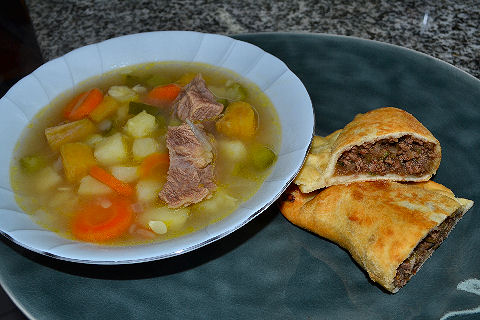
Not surprisingly, the food is heavily Dutch, and to a lesser extent Spanish, influenced, making use of native ingredients found on this 120 square mile island (6×20, roughly). My choices for its representatives in this project, Pastechis and Sopi Weso Blanco. Let’s start with the soup….
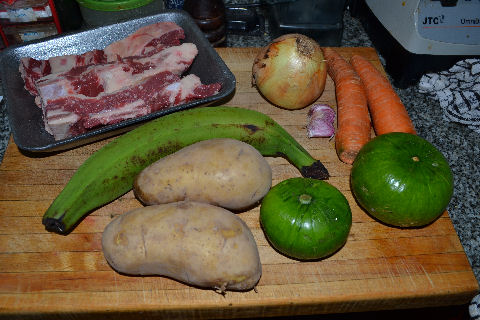
I know, I know, you’re all asking yourselves, “Why didn’t he make Sopi di Pampuna?” And while it’s true that it’s probably the soup that comes up most commonly in connection with Aruba, it was, in essence, just a pumpkin puree soup with very little different from the one we just did for Argentina – a little difference in spicing, and the addition of some salt beef, but otherwise, more or less the same. And in searching a bit more, I actually found several other soups that popped up regularly – seafood is obviously a common one, and fruit soups – though most of those were sweet, sounding more like something served in the afternoon as a refreshment. Weso Blanco, or “white bone”, popped up quite a bit, and, like any of these sorts of soups, had probably close to as many different recipes as their are families on the island (population is 103,000 or thereabouts). And it sounded delicious. And, Kevin jumped in and made the Sopi di Pampuna, which you can see here.
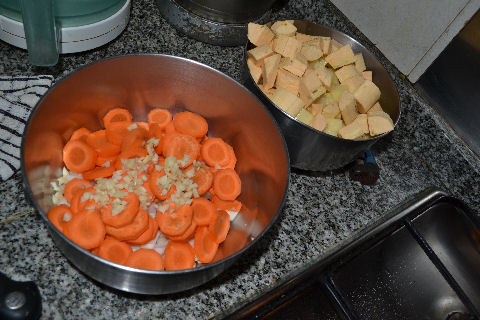
I started by boiling beef ribs, cut in small pieces, in beef stock, for about an hour, after first removing as much fat as I could. Then added in chopped onion, garlic, and sliced carrots, and let it simmer away for another half hour. At that point, in went the starchy ingredients, diced potato, globe zucchini (the closest I was going to come to “gem squash” here), and green plantain (among various alternatives that recipes suggest, with cassava, or yucca root, and taro root being the most common), and cooked until those were soft, about another 20 minutes. Seasoned to taste with salt and pepper. A simple and hearty soup, and absolutely delicious!
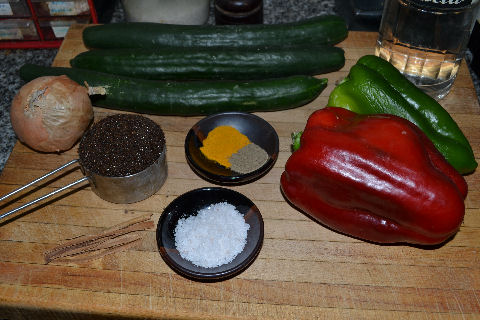
We are going to have to go off on a tangent here. Pastechis, the empanadas of Aruba, use Picalilli, a relish that isn’t something I can run down to the store and pick up a jar of, as Arubans can. Now, there are various forms of this relish, both Dutch and English, and even a very different version from the Pennsylvania Dutch (and all with different spellings). Given that I only needed a couple of tablespoons of it, to be honest, had I been able to get a decent jarred, turmeric-based pickle relish, I’d have just gotten some, but we don’t have any kind of pickle relish here that I’ve seen. (On Mercadolibre, our local equivalent of eBay, some guy is selling jars of Heinz turmeric pickle relish for 130 pesos for a small jar plus delivery, about 8 times what it would cost in the States.)
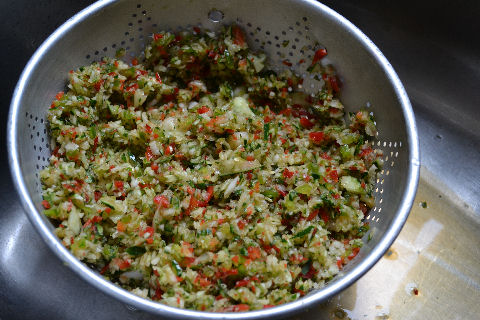
It took some searching to find an Aruban picalilli recipe too. Almost everything I found was either the English style, which is more of a pickled vegetable mix, with cauliflower and green beans and such – what I think of as a chow-chow, or the Pennsylvania Dutch green tomato relish. But, I found one.
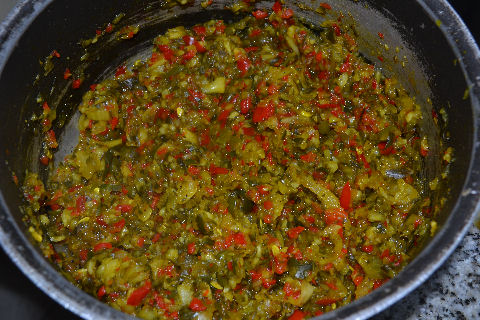
Coarsely chopped cucumbers (skin on), green and red bell peppers, and onions in the food processor, then salted them and left them to sit and drain for a couple of hours. Squeezed out the excess liquid and then cooked them down for about 15 minutes with cider vinegar, light brown sugar (there’s dark in the picture, but I realized when I got to that step that that was going to make a very dark picallili, and I went back and checked my source material and it had actually specified the light, so I switched it), turmeric, cinnamon, black pepper, and salt to taste. A new condiment to keep in my refrigerator on a regular basis!
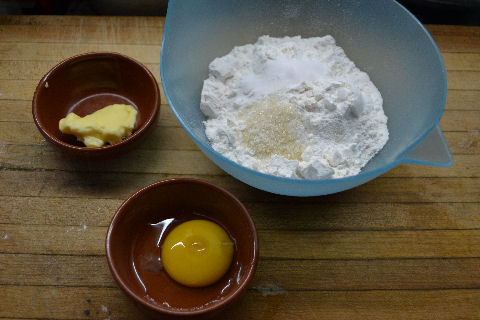
Back to our Pastechis. A simple dough, here a small batch, as we don’t need a ton of these sitting around, a cup of flour, a teaspoon of baking powder, teaspoon of sugar, and ¼ teaspoon of salt. An egg yolk and a tablespoon of softened butter. Mix all together well and add just enough water to bring it together into a soft, smooth dough. Set aside to rest.
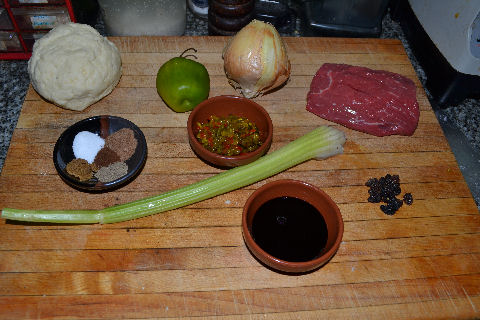
The filling – ½ lb beef (rib eye in this case), a medium onion, celery stalk, some raisins, 2 Tb picalilli, 2Tb soy sauce, ½ tsp each of salt, black pepper, cumin, and nutmeg. The question was, what to do about the chili component – the island classic uses Madame Jeanette chilies, which are a fiery yellow chili with a fruity note, but a heat level similar to Habaneros. So I went with a Rocoto for the fruitiness, and added in ½ tsp Habanero chili powder to give it more of a kick.
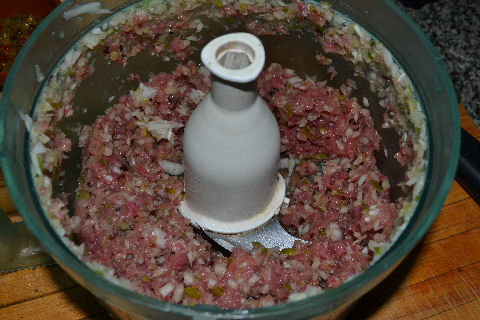
Into the food processor (yes, yes, I know, slow food and all that – trust me, if your great-grandmother had food processors available, she’d have used one) with the beef, onion, chili pepper, celery and raisins – processed fairly finely.
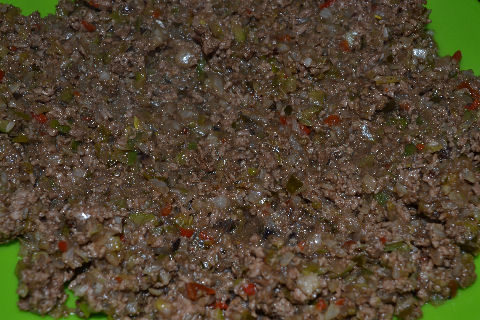
Cooked down in a little vegetable oil – I browned the beef and vegetables with the spices, and then added in the picalilli and soy at the end, just for enough time to cook out the liquid. Spread out on a plate to cool – you don’t want to be trying to put hot filling inside of dough.
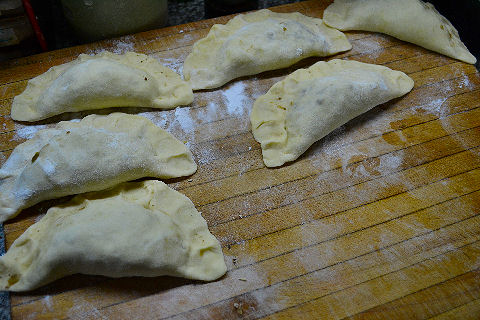
Divided the dough in six, rolled it out into rounds, split the filling up between them, folded them over and sealed them like I might seal a pie crust. Fried in vegetable oil. Eaten with, pun intended, great relish!
Next up, Australia. Do we go “Pie Floater“? Probably not, they’re really more of small pies than stuffed breads, and where would I find Vegemite?